
Hindawi Publishing Corporation
EURASIP Journal on Wireless Communications and Networking
Volume 2009, Article ID 261815, 10 pages
doi:10.1155/2009/261815
Research Article
The Performance of Relay-Enhanced Cellular OFDMA-TDD
Network for Mobile Broadband Wireless Services
Kyungmi Park,1Hyun S. Ryu,1Chung G. Kang,1Daeyoung Chang,2Seungho Song,2
Jongguk Ahn,2and Jongtae Ihm2
1School of Electrical Engineering, Korea University, Seoul 136-701, South Korea
2SK Telecom Access Network R&D Center, Seoul 100-999, South Korea
Correspondence should be addressed to Chung G. Kang, ccgkang@korea.ac.kr
Received 7 January 2009; Revised 20 April 2009; Accepted 20 May 2009
Recommended by Dmitri Moltchanov
A multihop relay (MR) and repeater are useful means for improving system throughput and coverage in a cellular mobile packet
access system, as the carrier-to-interference ratio can be improved when deploying them in a heavily shadowed region. In this
paper, we report on our investigation of bandwidth efficiency and the associated service outage performance for different relay
scenarios, using system level simulation for a cellular Orthogonal Frequency Division Multiple Access-Time Division Duplexing
(OFDMA-TDD) system. We have demonstrated that network throughput gain by typical optical repeaters, which have a simple
amplify-and-forwarding capability in a full-duplexing mode, could be minimal in open space subject to cochannel interference
from all repeaters in the neighboring cells. This is true, even though they are generally useful for warranting the outage performance
with a multiple order of combining gain, especially in the destructive area, for example, basements or indoors with heavy wall
attenuation, that naturally shields interference. Meanwhile, we show that multihop relays increase the average system capacity
(almost doubling the system throughput) by fully reusing the frequency in every relay station, while improving the per-user data
rate in the cell edges or improving the outage performance in the heavily shadowed areas.
Copyright © 2009 Kyungmi Park et al. This is an open access article distributed under the Creative Commons Attribution License,
which permits unrestricted use, distribution, and reproduction in any medium, provided the original work is properly cited.
1. Introduction
MultiHop relay systems are considered as a useful means to
enhance coverage, throughput, and capacity of mobile wire-
less broadband, for example, IEEE 802.16e mobile wireless
MAN (also known as Mobile WiMAX) [1]. The gains in
coverage and throughput can be leveraged to reduce the total
deployment costs for a given system performance require-
ment and thereby improve the economic viability of those
systems. The IEEE 802.16j MultiHop relay (MR) task group
is one example of standardization activities toward relay-
enhance cellular system (RECS). This group enables exploita-
tion of such advantages, specifying an OFDMA physical layer
and medium access control layer enhancements to the IEEE
802.16 standard for licensed bands to facilitate the operation
of relay stations [2]. Furthermore, the MultiHop relay is
considered an essential system element in the emerging IMT-
Advanced standard of ITU-R for next generation mobile
communication, including the 3GPP Long Term-Evolution
(LTE-)Advanced standard and IEEE 802.16m standard. In
the current development of standard specification, initial
efforts are required to understand the impact of relay nodes
on the system performance and furthermore, to identify their
advantages over the conventional repeaters [3].
The benefits of introducing the MR into the field,
compared to conventional optical repeaters in a cellular
system, include easy network deployment and a significant
reduction in infrastructure cost by replacing the wireline
relay link with wireless hops using the same frequency
assignment (FA) as the access link. Furthermore, through-
put and capacity enhancement can be achieved through
the frequency-reuse capabilities of relay stations (RSs). As
opposed to the selective decode-and-forward capability of
the MR, the typical optical relays may suffer from a serious
problem of co-channel interference between them in the
neighboring cells as a consequence of their performing a
simple (yet blind) amplify-and-forwarding function. When
a universal frequency reuse is employed, this particular
problem becomes more serious for OFDMA. OFDMA is
less robust to co-channel interference compared to (code

2 EURASIP Journal on Wireless Communications and Networking
division multiple access) CDMA. However, a portion of
the radio resource must be dedicated to the relay link in a
MR system; this naturally reduces the capacity of its access
link. This particular aspect becomes critical as the number
of relay stations connected to the base station (MR-BS)
increases. That is, there exists an obvious trade-offbetween
the frequency reuse gain and capacity loss associated with the
additional links between the MR-BSs and RSs.
In the case where radio resource is fully reused by all
the RSs, all subcells associated with the RSs are subject to
performance outage due to other cell interference around the
subcell edges. That is, a level of modulation and the coding
set (MCS) for the subscribers located in the cell edge can
be favorably boosted around relay stations. Meanwhile, all
subcells are subject to co-channel interference that results in
additional cellular outages. Conversely, a radio resource can
be also orthogonally allocated among all the RSs without any
frequency reuse, completely avoiding co-channel interfer-
ence in the same cell, while limiting co-channel interference
from adjacent cells only to some data regions. However, for
orthogonal allocation, the radio resource efficiency can be
significantly reduced without fully exploiting the reuse gain
of the relay system.
The nature of co-channel interference and resource
allocation must be properly taken into consideration to assess
the enhancement of system throughput and economical
feasibility by employing the different types of relay systems,
namely the optical repeater and MR. In this paper, we report
on our investigation of the bandwidth efficiency achieved
by the frequency reuse capability of a MR system and the
associated service outage performance, using system level
simulation for the cellular OFDMA-TDD system. Further-
more, the performance of optical repeater and MultiHop
relay is compared. We note that improvement of throughput
performance in the downlink with the MultiHop relays has
been demonstrated for CDMA and hybrid TDMA/FDMA
systems in [4,5], respectively. However, no explicit compari-
son between the repeater and relay systems has been made,
especially for the cellular OFDMA system that employs
adaptive modulation and coding schemes, in any of the
previous studies.
This paper is organized as follows. Section 2 presents
an overview of the cellular system with MultiHop relays
and conventional repeaters. Its system-level models and
simulation scenarios are detailed in Section 3. System-level
simulation results are given in Section 4, providing the
comparative analysis on throughput and outage performance
for the MultiHop relay and optical repeaters under varying
system conditions. Finally, concluding remarks are given in
Section 5.
2. System Overview: Multirelay
versus Repeater
2.1. A MultiHop Relay (MR) System. As shown in Figure 1,
a typical MR system consists of three station types: a base
station for MultiHop relay (MR-BS), a fixed relay station
(RS), and a mobile station (MS). The MS can communicate
with an MR-BS either directly or over a 2-hop via the
MR-BS
RS1
RS2
MS1
MS3
RS3 MS2
Figure 1: MultiHop relay-enhanced system.
RS. Even though more than two hops can be exploited via
multiple RSs, we consider a simple relay with two hops by
means of a single RS in the current analysis. The direct
links between the MS and the MR-BS and between the MS
and the RS are referred to as an access link, while the link
between the RS and the MR-BS is referred to as a relay link.
An RS implements a decode-and-forward (DF) function. A
signal from the MR-BS is decoded first and then forwarded
toward the MS and vice versa. As opposed to the amplify-
and-forward (AF) relay type, adaptive modulation and
coding (AMC) may be applied by taking the link condition
between the RS and MS that allows full exploitation of the
bandwidth by opportunistic scheduling between multiple
users. Furthermore, bandwidth assignment can be controlled
centrally by a packet scheduler in the MR-BS. As the
bandwidth assignment results are broadcast to all RSs and
MSs via a MAC management message, for example, the MAP
message in the IEEE 802.16 standard, each RS can selectively
serve the MSs only within its own coverage. This reduces co-
channel interference from the neighboring cells.
Depending on whether a broadcast control signal, for
example, MAP message, can be always reliably received
within the coverage area, the relay operation is classified
in two different modes: transparent and nontransparent
[2]. For the nontransparent mode, all MSs served by an
RS can receive the MAP message only via the RS, not
directly from the MR-BS. As it can serve as a usage mode of
coverage extension, it provides a most flexible relay function.
Meanwhile, the transparent mode will serve only as a usage
model of throughput enhancement, as it must operate under
the condition that the downlink signal is always reachable to
every MS within the coverage.
2.2. Optical Repeater. Carrier-to-interference and noise ratio
(C/I) can be significantly improved using repeaters. Hope-
fully, this can be achieved even in the shadow area by
properly locating the repeaters, as multiple signal sources
via repeaters can be combined in the receiver. In general,
the repeaters operate in full duplex mode, that is, receiving
and transmitting in the same time and frequency band. This
makes the wireless repeater infeasible, due to the RF isolation
required between receiver and transmitter as the transmit
signal may be 100–150 dB above the received signal. Even
While wireless repeaters that adopt a new technology, such
as interference cancellation system (ICS) become available,
their performance has not yet fully proven in the field. In the
current analysis, therefore, we consider the optical repeater
only, which can perform an amplify-and-forward function

EURASIP Journal on Wireless Communications and Networking 3
Repeater
BS1
Repeater
BS3
Repeater
BS2
Figure 2: Co-channel interference from an optical repeater from
neighboring cells.
with full duplex capability. It blindly amplifies the signal
received from the MR-BS or vice versa, as illustrated in
Figure 2, as opposed to a selective decode-and-forwarding
feature of the MR. In general, it is not known which
MS is served by each repeater. This makes it clear that a
frequency cannot be reused among the repeaters. Therefore,
all repeaters without a selective forwarding feature can be
a source of interference toward neighboring cells, reducing
overall system throughput. Meanwhile, an optical repeater
can use an entire radio resource for an access link, since
a relay link is provided by a wire line. This implies that
there must be proper trade-offinvestigations on throughput
loss due to co-channel interference originated by the optical
repeater, and reduction in radio resource dedicated to the
relay link of the MR in the repeater-enhanced and MR-
enhanced cellular systems, respectively.
3. Simulation Scenario and Modeling
In this paper, we report on our evaluation of the system-
level performance of an OFDMA/TDD-based mobile wire-
less broadband access system [6], enhanced with different
types of relays: MultiHop relay stations and repeaters.
Using system-level simulation, we derived insights toward
understanding throughput and outage performance with
a MultiHop relay system in a mobile wireless broadband
network [7].
3.1. Frame Structure. We consider a frame structure, one
especially designed for a two-hop scenario with a single
FA, corresponding to IEEE 802.16j. The frame structure
varies with two operational modes, but we focus on the
nontransparent mode. Figure 3 illustrates the frame struc-
ture for the nontransparent mode, seen from the individual
stations. In the nontransparent mode, each TDD frame is
divided into downlink and uplink intervals, each of which
is further divided into an access link interval for the MS
(i.e., used for the BS-to-MS and RS-to-MS links) and a
relay link interval for the RS (i.e., used for the BS-to-RS
link) [8]. A characteristic of this particular frame structure
is that its access link interval is shared with all MSs that
are communicating directly with the BS, or indirectly via
the RSs. For a nontransparent case, in which some of the
MSs might not be able to directly receive the MAP message,
bandwidth allocation results must also be relayed. Therefore,
two different MAPs for the MS must be transmitted in the
downlink, one for the MS directly served by the BS and the
other for the MS served by the RS. Furthermore, there must
be another MAP for the relay link, as it is orthogonally shared
by multiple RSs.
3.2. Resource Allocation Schemes. In this paper, we consider
a downlink for the Wireless Broadband (WiBro) system, a
mobile version of WiMAX, derived from the IEEE 802.16e
standard [1]. It is the OFDMA/TDD system with 768
useful subcarriers over a nominal bandwidth of 8.75 MHz at
2.3 GHz band. It has been designated for mobile broadband
Internet services in Korea. Each frame is composed of 42
OFDM symbols corresponding to 5 milliseconds. For the
asymmetric characteristics of typical internet traffic, we
assume a downlink/uplink ratio of 2 : 1, that is, 24 symbols
for the downlink subframe and 12 symbols for the uplink
subframe. The remaining symbols are used for preamble
and control information. A basic resource allocation unit
is given by a subchannel defined as a set of 48 subcarriers
selected either by a diversity mode or by a band AMC
mode. 384 subchannels are available for each frame (e.g.,
768 subcarriers/symbol ∗1 subchannel/48 subcarriers ∗
24 symbols/frame =384 subchannels/frame) in a downlink.
The boundary between access and relay link intervals must
be determined dynamically upon the trafficload.Inour
analysis, however, the boundary is statically determined to
maximize the average system throughput for the MSs uni-
formly distributed subject to the trafficmodelofafullbuffer.
Depending on the frequency reusability over the access
link intervals of the downlink, we consider two different allo-
cation schemes: the overlapped and orthogonal allocation
schemes. The orthogonal allocation scheme corresponds to
the case for not reusing the subchannels over the access link
interval, that is, no subchannels can be shared among the
MSs directly served by the BS and those served by the RSs.
Meanwhile, the overlapped allocation scheme corresponds to
the case where all subchannels in the access link interval are
shared among all MSs throughout the cell coverage, whether
or not the MS is directly served by the BS. While allowing
for maximizing the bandwidth efficiency, this scheme tends
to suffer from co-channel interference. This interference
reduces the overall system throughput and furthermore,
induces outage events around the subcell edges, as well as
the boundary of each cell. As far as a relay link interval is
concerned, all corresponding subchannels are orthogonally
divided for the RSs and thus, they are not subject to any co-
channel interference.

4 EURASIP Journal on Wireless Communications and Networking
BS MS
Preamble Preamble
MAP for MS
MAP for RS
MAP for MS
BS RS Listen
(MS BS)
Midamble
Listen
(RS BS)
Downlink Uplink
Listen
(MS RS)
Listen
(BS/RS MS) Null
MR-BS
RS
MS
Access zone Relay zone Access zone Relay zone
RS MS Listen
(BS RS) RS BS
MS BS/RS Null
Figure 3: Frame structures for IEEE 802.16j MultiHop relay network [5].
3.3. Carrier-to-Interference and Noise Ratio (CINR). In the
current analysis, we consider a diversity mode that forms
the subchannels through a given pattern of subcarrier
permutation. Thus, a CINR of each MS is determined by
taking the average of all subcarriers assigned to it. Let Ctotal,k
denote a received signal power of subcarrier kwithin the
subchannels assigned to the MS and let Itotal,kdenote the
corresponding interference. Then, the average CINR for each
MS can be represented by taking the average of all subcarriers
used by them, as follows:
C
I=1
Nused
Nused
k=1
Ctotal,k
Itotal,k+N0×NF,(1)
where N0and NF denote the thermal noise power and
noise figure, respectively, while Nused denotes the number
of subcarriers used by the MS. In a cellular system, without
employing any type of relay, an MS is interfered with only
by the neighboring BSs. Therefore, the total interference
for the subcarrier kcan be determined by subtracting a
total received signal power from a received signal power for
serving the BS for the corresponding subcarrier as follows:
Itotal,k=
NS
j=1
PBSj,k
received −Ctotal,k,(2)
where PBSj,k
received denotes the received signal power for subcar-
rier kof a subchannel assigned to the MS served by the BS
j.NSis the number of the BSs. In the sequel, we present the
C/I models for the MultiHop relay-enhanced and the optical
repeater-enhanced cellular system.
3.3.1. The MultiHop Relay-Enhanced Cellular System. In this
case, Ctotal,kand Itotal,kvary with resource allocation type.
The overlapped allocation exhibits intracell interference
between the access links (BS-MS links and RS-MS links),
as well as other cell interference from all the BSs and RSs.
The corresponding interference for the subcarrier kof the
subchannels assigned by serving the BS ican be represented
as follows:
Itotal,k=
NS
j/
=i
⎛
⎜
⎝PBSj,k
received +
Nrj
r=1
PRSj,r,k
received⎞
⎟
⎠+⎛
⎝PBSi,k
received +
Nri
r=1
PRSi,r,k
received⎞
⎠
−Ctotal,k,
(3)
where PBSj,k
received and PRSj,r,k
received denote the received signal power
for the subcarrier kserved by BS jand the received signal
power for the subcarrier k served by the RS rassociated with
BS j,respectively,whileNrjis the number of RSs associated
with BS j. The first term in (3) represents the other cell
interference, while the next two terms represent intracell
interference among the access links.
Conversely, no intracell interference exists in orthogonal
allocation. Other than a BS-MS link, only one of the RS-MS
links in the neighboring cells is accounted for the other cell
interference in each OFDM symbol. The level of interference
from an RS-MS link in the other cell depends on which RS
is activated by the bandwidth assignment in the same data
region. In the current analysis, we simply take the average of
the potential interference from all the RSs in the neighboring
cells, assuming bandwidth is randomly assigned among all
RSs, to reduce the simulation complexity. Let α(k)
jand β(k)
j,r
denote the probability that the subcarrier kis allocated to
the MS served by BS jand the probability that the subcarrier
kis allocated to the MS served by RS rassociated with BS
j, respectively. Then, the average interference from all other
cells can be represented by
Itotal,k=
NS
j/
=i
⎛
⎜
⎝α(k)
j·PBSj,k
received +β(k)
j,r·
Nrj
r=1
PRSj,r,k
received⎞
⎟
⎠−Ctotal,k.
(4)
Assume that the same number of RSs are deployed in every
BS (i.e., Nrj=Nr,forallj), and furthermore, each BS and

EURASIP Journal on Wireless Communications and Networking 5
RS serves the same number of MSs. In (4), we set α(k)
j=
β(k)
j,r=1/(Nr+ 1), assuming that radio resource is uniformly
assigned among BS and all RSs in each cell.
3.3.2. The Optical Repeater-Enhanced Cellular System. As the
MS combines all signals from the BS and all repeaters in the
same cell, total received signal power can be represented as
follows:
Ctotal,k=PBSi,k
received +
Nri
r=1
PRSi,r,k
received.(5)
The level of intercell interference may vary with the envi-
ronment, for example, outdoor, indoor, or heavily blocked
basement. Let us introduce an average interference factor
l(j,r)
p, defined as a ratio of the power loss due to the additional
attenuation for a repeater rassociated with the BS j(0 ≤
l(j,r)
p≤1). Then, the total interference for subcarrier kis
represented as follows:
Itotal,k=
NS
j/
=1
⎛
⎜
⎝PBSj,k
received +
Nrj
r=1
PRSj,r,k
received ·l(j,r)
p⎞
⎟
⎠.(6)
We assume the same interference factor for all repeaters
to simplify this analysis, that is, l(j,r)
p=lp,forallj,r.
The worst-case scenario corresponds to lp=1, where no
additional attenuation is imposed by environmental factors.
In the case where selective amplify-and-forwarding can be
implemented for the repeaters, in a similar way as in the
MultiHop relays, then only one of the repeaters will become
the source of interference from each of the neighboring cells.
Thus, we can assume that lp=1/(Nr+1)whereNris the
number of repeaters deployed for each cell. In this case, it
behaves as an ideal repeater.
3.4. TrafficModels. We consider two different types of traffic
models in the current analysis, one for a simple Internet
traffic model observed from the empirical data of Ethernet
traffic, the other for a full buffer. For the Internet model, the
interarrival time between subsequent packets, T, follows the
Pareto distribution. It best captures the self-similarity and
burstness inherent in Internet traffic. The interarrival time
is determined by two parameters, a shape parameter αand a
location parameter β; this leads to the following cumulative
distribution function [9,10]:
FT(t)=⎧
⎪
⎪
⎪
⎨
⎪
⎪
⎪
⎩
0, if t≤β,
1−β
tα
,ift>β,
(7)
Note that the average packet interarrival time is given by
E[T]=αβ
α−1=1
λ,ifα>1, (8)
where λdenotes the average packet arrival rate. In the full
buffer model, assume that the base station has packets to
transmit for all mobile stations, waiting in their individual
downlink buffer.
The Internet traffic model is useful for assessing the
number of mobile stations that can be supported simulta-
neously under varying traffic load, in terms of the average
packet arrival rate. In contrast, the maximum possible system
throughput can be evaluated with the full buffer model,
only reflecting the multiuser diversity gain into throughput
performance.
4. Simulation and Performance Analysis
An ideal hexagonal cell is assumed for each site, while con-
sidering only two tiers of cells with respect to a reference cell
in the center, that is, considering 19 cells in our simulation.
Each site is sectioned by a directional antenna. Due to
the finite number of cells, an accurate level of interference
from all other cells cannot be captured in the model. We
consider a so-called wrap-around structure to remove such
a boundary effect. This enables capturing a more accurate
level of intercell interference [6,11]. The MSs are uniformly
distributed throughout each cell and move at a velocity of
3 km/h along a direction randomly selected in each frame.
A path loss follows the WINNER model [12]. A log-normal
shadow fading model with a standard deviation of 8 dB is
considered for large-scale fading. Meanwhile, a multipath
fading model follows the ITU-R M.1225 recommendation
[13] for a pedestrian A (PED-A). An individual multipath is
subject to independent Rayleigh fading, whose time-domain
correlation is implemented by Jake’s model [14].
We assume that 100 mobile users are uniformly dis-
tributed throughout each cell. We deploy 6 relays (or
repeaters) in each cell located around a BS at a 2/3 position
between the BS and the cell boundary. The transmit power
of the BS and RS is limited to 20 W and 10 W, respectively.
Meanwhile, we consider a full buffer traffic model, that is,
each MS always has packets to transmit in the buffer. A sim-
ple round-robin packet scheduling algorithm is employed.
Tabl e 1 is the MCS table used in the simulation. It shows the
CINR levels required for the given modulation and coding
set (MCS) subject to the given channel model. Our analysis
focuses on the nontransparent mode.
4.1. Performance of MultiHop Relay System. We first consider
the performance of the MultiHop relay-enhanced cellular
OFDMA system for two different allocation scenarios: over-
lapped and orthogonal allocations. In this particular analysis,
we employ the Internet traffic model with an average packet
arrival rate of λ=75 packets/sec, corresponding to a data
rate of R=441.72 kbps. Furthermore, a shaping parameter is
fixed as α=1.3. In addition, the packet length is randomly
generated by statistics obtained by an actual measurement
in an Ethernet, as presented in Table 2. Each packet is
fragmented into the appropriate sizes of a MAC PDU and
padded with dummy bits, if necessary, to fit in the FEC block
of the PHY layer.
As a downlink resource is divided for access and relay
intervals, a proper boundary between them must be deter-
mined for load balancing. The current analysis varied the

![Mẫu Báo cáo tiến độ thực hiện đề tài [chuẩn nhất]](https://cdn.tailieu.vn/images/document/thumbnail/2025/20250318/tuongmotranh/135x160/1241742262566.jpg)
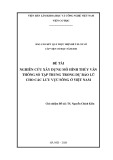


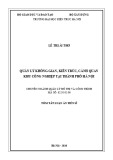
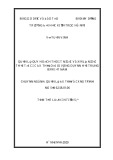
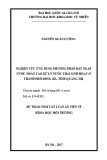
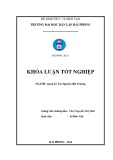






![Báo cáo seminar chuyên ngành Công nghệ hóa học và thực phẩm [Mới nhất]](https://cdn.tailieu.vn/images/document/thumbnail/2025/20250711/hienkelvinzoi@gmail.com/135x160/47051752458701.jpg)










